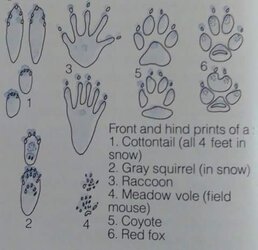CoNiGMa
Member
- Joined
- Aug 4, 2017
- Messages
- 22
- Reaction score
- 46
- Location
- Florence, SC
- Website
- www.peedeeparanormalsociety.com
Animal Tracking:
Because wild creatures usually stay in hiding after a snowstorm, look for tracks about 24 hours later. You can also find tracks in mud or wet sand along beaches, streams, and lakeshores almost any time.
Tracks made by members of the dog family are among those most often seen. Domestic dog tracks, however are difficult to distinguish from those of the dog's wild relatives -- the wolf, coyote, and fox. To decide if tracks were made by those of a wild animal, study the course or route of the tracks. A domestic dog will go directly up to a house or other place used by people, whereas a wild animal will cautiously skirt around it.
The tracks of a domestic cat are recognizable by the small, neat paw marks and a cat's habit of placing its hind paws in the marks of its front paws.
Tracks tell you not only which animal passed by but also the speed and mode of its movement. A rabbit, for example, places its powerful hind feet right up through and ahead of its front feet with each hop, leaving a fan-shaped cluster of footmarks.
Mice and some of the tree climbers such as raccoons and squirrels, leave long prints resembling human handprints. When running, tree climbers place their front feet together.
Because wild creatures usually stay in hiding after a snowstorm, look for tracks about 24 hours later. You can also find tracks in mud or wet sand along beaches, streams, and lakeshores almost any time.
Tracks made by members of the dog family are among those most often seen. Domestic dog tracks, however are difficult to distinguish from those of the dog's wild relatives -- the wolf, coyote, and fox. To decide if tracks were made by those of a wild animal, study the course or route of the tracks. A domestic dog will go directly up to a house or other place used by people, whereas a wild animal will cautiously skirt around it.
The tracks of a domestic cat are recognizable by the small, neat paw marks and a cat's habit of placing its hind paws in the marks of its front paws.
Tracks tell you not only which animal passed by but also the speed and mode of its movement. A rabbit, for example, places its powerful hind feet right up through and ahead of its front feet with each hop, leaving a fan-shaped cluster of footmarks.
Mice and some of the tree climbers such as raccoons and squirrels, leave long prints resembling human handprints. When running, tree climbers place their front feet together.




